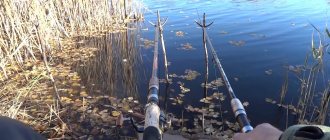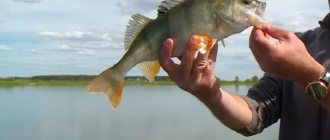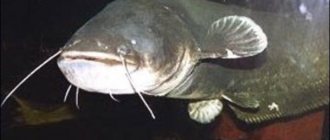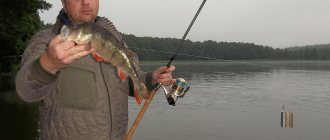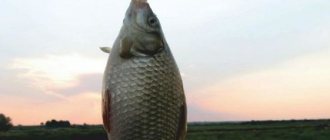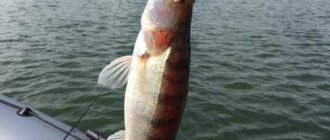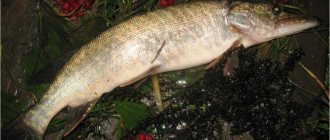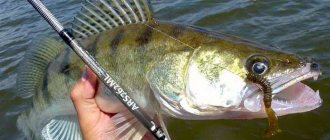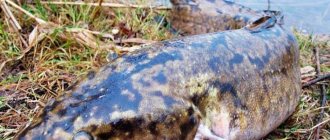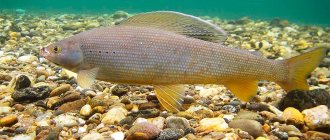In this article I want to share some of my experience, express my opinion and draw conclusions regarding microjig fishing in bodies of water without a current (reservoirs, lakes, ponds, etc.).
First acquaintance with microjig
It’s the end of July, the air temperature is +30°C, the water temperature is + 23.5°C (even at that time I had been keeping a diary of my fishing trips for about 12 years, and in total my fishing experience was more than 20 years). Fished in a large deep-sea quarry with very clear water. Before that, my success in spinning fishing was limited to catching pike with spinners and spinners. All attempts to catch the predator using silicone baits ended in failure. By the way, in my rich assortment of spinners at that time there were only a couple of jig heads weighing 3-5 grams and several 2- and 3-inch twisters.
I used a medium-fast spinning rod, 5–20 g test, 2.1 m long. I used monofilament with a diameter of 0.24 mm as a fishing line. After several fruitless hours of fishing with turntables, once again, without any hope, I attached a jig head weighing 4 grams + a 2-inch brown Relax twister. Literally on the first retrieve, when the twister reached the edge, there was a powerful push, and a 250-gram perch was on the hook. There was no limit to the joy - the first fish on a silicone bait! As a result, 25–30 perch ranging in size from 100 to 250 grams were caught that day...
In the future, all my efforts and efforts were aimed at catching perch. What attracts me to perch fishing is its abundance and almost ubiquitous habitat. For the time being, the most commonly used technique when fishing for perch was dragging along the bottom with all sorts of options. If the likelihood of snags increases, then I use a twister on a small offset machine connected through a small winding ring, or through a microclasp with a Cheburashka weight. I use this type of wiring in the spring, summer and early fall. Although in my practice there are pleasant and unexpected exceptions.
Let me give you a small example. Fishing at the end of November, air temperature +5°C, water temperature +5.5°C, cloudy, calm, large reservoir. My partner and I swam out late; more than 20 boats in the water area were waiting for the probable appearance of perch and pike perch. The fishing depth is 4.5–5 m, the bottom is rocky with an abundance of shell rock. I never like to fish in a crowd, so we stood a short distance from the main mass of anglers.
The tackle is the same, only monofilament line with a diameter of 0.14 mm, a 5 g jig head, a 2-inch Relax twister (transparent with multi-colored sparkles). My partner has the same spinning rod, but instead of mono, it has 0.08 mm braid, a 5 g jig head, and an inch “machine oil” twister. As we swam past the bulk of the fishermen, we were greeted with surprised glances. As one of the fishermen later admitted on the shore after fishing, everyone was confused by our miniature gear. Almost everyone fished with the classic step on more powerful gear with 6-10 gr jigs and 2-3 inch vibrating tails. After an hour of fishing, we only had a couple of average perches and a few indistinct bites.
After changing the jig to a lighter 4 gram, reducing the twister to 1 inch and reducing the retrieve speed to extremely slow, I finally felt a bite in the form of a light hook. Imagine my surprise when, after several minutes of struggle, a huge perch (as it turned out later, 680 grams) came to the surface. When removing the twister, I noticed that the perch’s mouth was filled with fry 2–4 cm long. Within 1.5 hours, I caught 6 more perches weighing from 450 g to 1100 g! At the same time, my partner managed to persuade only one perch over 300 grams. Our manipulations did not go unnoticed, and soon we found ourselves in the center of the crowd, but finally, in front of everyone, I pulled out a pike weighing more than 2 kg...
About equipping a microjig
The weight of the jig heads that I mainly use is 1-6 grams, depending on the fishing conditions: depth, degree of overgrowth, wind strength, etc. Size of baits used: twisters 1-2 inches long. Why twisters? Because I like their active play. A few words about color. From printed publications I have already heard about how a predator gets used to the most commonly used colors of bait in a particular body of water and, accordingly, ignores them. Since I fish mainly in 6–8 heavily pressurized reservoirs, not far from a big city, after a while I noticed that the predator, mainly perch, began to ignore the colors of the baits I used (all kinds of green colors with shades and sparkles). So I gradually switched to darker and more contrasting colors (machine oil, tea, cola, black, etc.).
I also have a separate box in my arsenal with very bright colors that have helped me out more than once (yellow, white, orange, light green). I already wrote above that fishing takes place on shell rocks, pebbles and where pike are very common. At first, I ended up wasting quite a lot of bait due to the sawn-off shotgun hitting shells and pike teeth. Therefore, I began to draw conclusions and look for a way out of the current situation.
I tried using microleaders from guitar string and all sorts of thin leader materials, but I noticed a significant decrease in the number of perch bites, especially in early spring and late autumn. And at some time I discovered fluorocarbon, which noticeably reduced the consumption of bait and increased the number of pike delivered to the shore, and also achieved a slight increase in the total number of bites by the predator. Some may ask: why monofilament and not braid, especially in microjig?
When I started mastering microjig, I had only vaguely heard about braided, at that time it was not a cheap pleasure, and in our city there was no talk at all about the choice of thin, high-quality braids, so I began mastering microjigging by using monofilament fishing line. And I consider the main advantage of monofilament to be its stretchability. Some time after I started mastering microjigging, I had like-minded people and friends who were passionate about microjigging, but used thin braid as the main fishing line. So there was someone and something to compare with. It’s not for nothing that I mentioned above about my partner’s “successes” on that memorable perch fishing trip.
He had braid as his main line. The number of bites we had was approximately the same, but at the slightest touch of the twister by the perch, it instantly made a hook, which ended in a derailment or the tail being torn off from the twister. Because of the stretchability of the fishing line and, accordingly, its “inhibition,” I yawned the first phase of the bite, when the perch only lightly touches the bait, and then it swallowed the twister, suspecting nothing, and only then did I make the hook. The perch bite that day was very capricious. Even more indicative is one August fishing trip also on a large reservoir. The fishing depth is 3.5–4 m, in places there is shell rock, the bottom is very hard. A big wave. My gear is the same, my partner has 0.09 mm braid as the main line, and a G. Loomis 842GLX spinning rod. The goal of fishing was perch 100–150 grams, which was found in large numbers in that area.
Because of the large wave, it was extremely difficult to retrieve; every part of the body was under maximum tension (we fished on the “Nyrka-41” and “Ivolga-21”). The bites followed one after another, but it was still very difficult to catch the moment of hooking. Once again the stretchability of the fishing line came to the rescue. Through the spinning rod, I felt the perch touching the bait, paused for 1-2 seconds and hooked - the entire perch was caught at the edge of the upper lip. The result is about 60 perches, several catches and one bitten off tail of the twister. No matter how hard the partner resisted, no matter how hard he tried to pause, it all ended the same way - either with the tail torn off from the bait or with the perch disappearing. The result is 2 perches, dozens of unrealized bites and more than 30 bitten off tails of the baits! It is for this type of wiring that I see another slight advantage of monofilament fishing line over braided line - the ability to use slightly lighter weights of jig heads on the fishing line due to its lower windage.
I want to say a few words about fishing. Quite often I had to catch good perches (personal best 1280 g) from depths of 3–6 m, and almost never there was a disappearance in the period of 10–20 seconds after hooking and before being raised to the surface, taken into a boat or ashore. I fish with the clutch tightened and try not to touch it while fishing for perch, with the exception of isolated cases (pike and pike perch, but this will be discussed below). The fishing line with its stretch, coupled with a good spinning rod, forgives a lot and allows you to deliver the perch to the shore or to the boat even with excessively tough fishing.
Catching pike with micro jig
The second most important predator for me is pike. Not far from the city where I live, there is a beautiful body of water, all cut up by underwater spits, with the most complex bottom topography. Maximum depths (8–10 m) in some places approach the shore or border on extended shallows. For me, this reservoir is a kind of training ground where I improve in fishing, primarily for pike. On it I picked up an almost universal wiring for pike (with which I start fishing in any body of water) - this is the same dragging along the bottom with periodic sharp and short separation of the bait from the bottom. In early spring and late autumn, it happens that wiring works with short pauses, when the bait remains on the bottom for 2-4 seconds. The gear is the same as when fishing for perch, but there are some adjustments.
As the main fishing line I use monofilament with a diameter of 0.16 mm, fluorocarbon leaders with a diameter of 0.34–0.38 mm and a length of up to 30 cm. I use jig heads from 1 to 6 g. Twisters 2–2.5 inches. As for color, the palette is similar to that for perch. When fishing for pike and pike-perch, I pay close attention to setting the reel’s clutch and working with it correctly, since the specimens that are sometimes caught on a microjig are simply amazing. Early May, my favorite training ground. Weather: light cloudy, air temperature +17°C, water temperature +11.5°C, slight wind. Fishing is carried out from the shore. We arrived at the reservoir before dark, in a group of 4 people, separated, and at some distance from each other began to move along the rugged shore. If we go fishing with a group, we always fish with different baits. I have a 3.5 gr jig head + 2 inch twister (machine oil with glitter).
About two hours later I had 5 qualifying pikes (over 35 cm), one over 1.5 kg. And several perches from 150 to 300 gr. The friends had already passed what looked like a very promising place - an underwater spit, on one side a sharp drop of up to 5 m, on the other - a rocky shallow. I decided to stay on it and fish it carefully. The bite occurred 8–10 m from the shore, at a depth of about 3 m and looked at first like a twister getting stuck in the grass, and then followed by a sharp jerk (very often this is how a good pike bites).
He made an instant hook - a smooth powerful jerk followed, immediately released the clutch and did not remove his hand from it until the end of pulling it out, successfully manipulating it. The first jerk of the pike released 60–80 m of line (I always have at least 150 m on the reel). I won’t bore you with the details of the fight, which lasted more than 1 hour and 40 minutes. Only on the 12th time did I take her to the sandbank, where she ran aground like a submarine. The strength left her and me too. It turned out to be 8.65 kg and 107 cm long.
Who to catch
The main object of microjig fishing is perch. Its population is large in almost any body of water, it is active and greedy, so it often ends up on the hook. In addition to perch, goby, roach, silver bream and other whitefish can bite on microscopic bait. Often the bait is also attacked by a warbler pike, but in the absence of a fluorocarbon leash, the pike’s bite often ends in the loss of both the trophy and the bait. If in a more “adult” light spinning rod larger baits are used and the pike is often hooked by the edge of the mouth, then in a microjig the bait is always completely swallowed. In this case, contact of the braid or leash with the pike’s teeth is inevitable.
Stepped wiring in microjig
What is mastering microjig without a classic step? Some time ago I had the opportunity to meet an experienced angler who fishes exclusively with a step, and the results are very impressive. And so, having heard a lot about the possibilities of this wiring, I decided to try it. Those two years during which I mastered the step turned out to be very interesting and productive. Drawing conclusions after such a short period of time of mastering a new method of fishing for me is probably a thankless task, but I express only my opinion and give examples exclusively from my practice, based only on personal experience.
As the main fishing line I use monofilament with a diameter of 0.16 mm, fluorocarbon leaders with a diameter of 0.34–0.38 mm and a length of up to 30 cm. I use jig heads from 1 to 6 g. Twisters 2–2.5 inches. As for color, the palette is similar to that for perch. When fishing for pike and pike-perch, I pay close attention to setting the reel’s clutch and working with it correctly, since the specimens that are sometimes caught on a microjig are simply amazing. Early May, my favorite training ground.
Weather: light cloudy, air temperature +17°C, water temperature +11.5°C, slight wind. Fishing is carried out from the shore. We arrived at the pond before dark in a group of 4 people, separated, and at some distance from each other began to move with it, you can achieve perfect contact with the bait on a light jig head and feel the bite, sometimes very cautious. I use jig heads 3–6 grams, twisters 2–2.5 inches long (occasionally I use 3-inch baits, specifically when fishing for pike).
Fluorocarbon leashes with a diameter of 0.34–0.38 mm and a length of up to 50 cm with fasteners size 00. I use long leashes when fishing at shallow depths to increase the gliding phase of the bait. But this year, my friend and I mastered an even more exciting and effective way of catching pike and perch in shallow water in the spring. All fishermen know that pike come out to shallow water in the spring, and that’s where you need to look for pike, which at this time often includes large perch. This is fishing using the so-called “parachute”. I make it from a plastic bottle, the oval size is 2–4 cm by 1.5–2.5 cm, depending on the fishing depth and the weight of the jig head and bait used. This device significantly increases the planning phase of the bait above the bottom, even in the smallest places, increasing the planning time of the bait by 2-3 times, which thereby remains longer in the field of view of the predator.
The installation looks like this: in a plastic oval I make 5 small holes with a very heated awl tip, I make 2 holes located on the opposite edges of the oval (in length) along the central axis of the oval, and I place the other 3 holes between these two in a zigzag pattern, trying to maintain the same distance between all the holes (this is done so that the “parachute” does not move freely along the braid). The braid is pulled into these holes in a zigzag, and the “parachute” is mounted at the end of the braid, in front of the leash. The results exceeded all expectations, sometimes from one shallow water it was possible to catch up to 5 pikes and several good perches!
Looking through my fishing reports in late autumn and winter, I noticed that the largest number of pike were caught in snags. Therefore, when I find even a small snag at the bottom, I try to linger in this place longer. I pass the bait at different angles relative to the snag, making a very short step, literally one or two turns of the reel, in order to catch it more carefully and thoroughly, since the pike in the snag is local and it will not chase the bait all over the place.
Having carefully fished one place, I try to find another, giving the first one a rest. But I’ll definitely go back to what I was before, because you can get caught in a pike exit, which can happen more than once during the day. Another good reason why I was interested in mastering the step was the desire to catch pike perch. In all the reservoirs where I fish with microjigs, it is present to one degree or another.
When fishing by dragging, pike perch was caught extremely rarely; it prefers the vertical component of the retrieve present in the step. During all the time I was fishing, I caught no more than 10 pike perch, all up to 1 kg. Before catching pike perch on a microjig, I dug through a bunch of articles in various fishing publications, watched many programs and videos on catching pike perch, and talked with seasoned pike perch anglers. And this brought results already on the second targeted fishing for pike perch. Let me give you an example. Beginning of June, air temperature +18°C, water temperature +13°C, clear.
Lure – jig head 4.5 g + 2-inch Relax worm color with sparkles. I’ll make a small digression regarding the twisters I use when fishing for pike perch. My favorites are yellow Mann's 2.5 inches, worm, light green, machine oil with red sparkles. Since I don’t yet have an echo sounder and navigator in my arsenal, I had to look for a promising place - a hard bottom with shell rock, the presence of snags on the bottom, changes in depth, using the method of fishing areas of the water area and visual observation. Fishing was carried out near the islands.
The search for the place took about 5 hours, but it was still found at a depth of 5.2 m. It is difficult to convey my state when, after several wires, I felt a clear, but not strong blow to the hand - I automatically made a short hook and at the other end of the braid I felt a pleasant heaviness. After ten minutes of fishing, there was a 2 kg pike perch in the boat. When catching predators, I never use a landing net; I catch all the fish with my hand. Within 3 hours, another 10 pike perch from 1 to 2.5 kg were caught! In the next three fishing trips, over the course of a week, 22 more pike perch were caught, the largest of which weighed 4 kg (and this was on ultralight!). This is how my acquaintance with pike perch happened!
Gear selection
The selection of gear should be approached with great responsibility, since the success and comfort of the event will depend on it. The fishing tool must have sufficient sensitivity and be made of quality materials. Particular attention should be paid to its balance.
Rod
Microjig fishing can be done on a rod 1.5-2.7 m long, but the best results are observed when using spinning rods 1.8-2.4 m long. When working with long rods, it is possible to cast the bait as far as possible, and with short rods it is easier attract the predator's attention through spectacular play.
The action of the rod for microjigging is fast, which allows you to constantly monitor the behavior of the bait under water and hook it with a slight flick of the tip. The spinning tip can be of two types:
- Tubular, characterized by a high degree of rigidity. The tip, which is hollow inside, is capable of providing excellent sensitive contact with the hand and effectively dampening the jerks of the predator. The main advantage of this type of ending is comfortable and safe fishing.
- Solid, distinguished by a high degree of susceptibility. It is good to use for examining the bottom, since it is able to sense all its changes. When fishing for prey, you should act carefully; aggressive jerks can damage the tip.
For information! The test load of the rod is selected taking into account the weight of the baits used. The upper limit of the spinning rod is 12 grams.
Coil
When choosing a reel for microjigging, it is better to give preference to spinning models with sizes 500–2000. As a rule, the requirements for a reel in jig fishing are not as high as for twitching. The main thing is that it is a reliable “meat grinder” like Daiwa and Shimano . The advantage of the reel will be the presence of 1-2 spare spools, which will allow you to have two options with different types of fishing lines.
Line and leashes
Fishing thread is suitable for both monofilament and braided types, with a breaking load of about 3 kg. It is more effective to use monofilament for fishing in the coastal zone, and for hunting cautious predators. But the use of braided cord will be relevant for casting bait at a distance of over 15 m from the shore. With its help, the tackle will acquire higher sensitivity and will allow for high-quality wiring. And this is very necessary to track any contact of the bait.
Gear for microjigging must be equipped with a leash in order to be able to:
- camouflage the gear at the fishing point;
- protect it from abrasive damage;
- protect from pike teeth.
When fishing for pike with a microjig, only metal leashes can be used to protect the tackle from being cut by the toothy predator. As an option, you can use fluorocarbon leaders, but if the cross-section is within 0.4-0.5 mm. But this design is more suitable for catching pike perch, peaceful fish, and perch using a microjig.
Accessories
Considering the ultralight nature of the equipment, it is not advisable to use swivels and carabiners. You can mount a jig head or hook directly to the main thread or leash. This technique will make it possible to create maximum stealth of the gear.
Jig heads and hooks
When microjig fishing, it is equally effective to work with equipment made from jig heads, and equipment that uses single or offset hooks with separate sinkers, or without them at all. The latter solution is more advantageous, since the game with this design of equipment is smooth and realistic. To attract the attention of passive prey, it is recommended to fish without weight, in order to provoke the target by slowly falling the bait.
Conclusions about catching a predator using a microjig
In conclusion, I would like to draw some conclusions regarding the predator, based on the time of year and daily activity. I would like to immediately make a reservation that I will draw conclusions regarding spring based on coastal fishing, since in our republic there is a ban on fishing from a boat from April 1 to May 31.
Pike fishing
Pike - Activity begins in mid-April, increasing towards the end of the month and reaching its peak in the first half of May. At this time, the largest number of bites occurs in the first half of the day, but not in the very morning, but somewhere from 10–11 o’clock. At the end of April - beginning of May, good catches occurred in the second half of the day (especially in cloudy weather). By the beginning of summer, the bite gradually subsides, although you can catch short-term exits. In the summer, I purposefully prefer not to catch pike, giving preference to perch and pike perch. But already from mid-August, the number of pike bites when fishing for two other predators begins to increase, reaching a peak in October–November. Although in the last few seasons we have often had to catch a crazy pike rush at the end of November - beginning of December. In December, while there was still no freeze-up, I was lucky enough to take part in the so-called “pike party meeting”, when up to 5-8 tails were caught from the point! As a rule, in the fall the first half of the day works best, but closer to winter, bites can continue throughout the daylight hours and often there are more of them after 14–15 hours.
Perch fishing
Perch - Activity begins to appear a little later than pike. This is most likely due to the later spawning, which reaches its peak in May (we are talking about perch over 150–200 g). Activity is also better after 11–12 o’clock, which decreases by 17–18 o’clock, but there are evening outings of large perch. In June - July, perch is also caught well, but fishing is very difficult, since it still moves scatteredly. Large perch are most often caught in the evening and even at dusk. But there are rare and pleasant exceptions. End of July 2010, large reservoir.
Strong bloom of water, air temperature +35°C, water temperature + 27°C. In the morning we went out to catch a small perch, which was biting well at that time near the islands. Having caught several perch, we concluded that the oppressive heat also affected the perch. But we decided to check how things were going with the pike-perch fishermen, several of whose boats were at the points. The results were also not impressive - just a few pike perch? We decided to anchor a few tens of meters away from them. Already on the first cast the perch landed over 300 grams! Within 1.5 hours there was practically no empty wiring. The size of the perch was simply amazing - 300–1000 g. The bait that worked best was an inch 2-tail tea-colored Relax twister on a 4-gram jig head. Fishing depth 4.5 m. Wiring - dragging.
This celebration lasted 4 days! In August, the perch gradually begins to flock together, and fishing becomes very interesting and productive; the bite can continue throughout the day. With the arrival of autumn, perch activity increases and reaches its peak in October. In November - December, the number of bites often decreases noticeably, but the chances of catching a real trophy increase. But unlike pike, during this period the best fishing time is in the first half of the day.
Fishing for pike perch
Pike-perch - Pike-perch activity begins at the end of March (where it can be reached from the shore and where open water has already appeared), and continues until mid-April. The bite is observed throughout the day. In the first half of June, zhor is observed. By the end of June the bite weakens. I would like to make a reservation that I monitor pike perch only for two fishing seasons.
At the end of August - beginning of September, when fishing for perch, pike perch bites begin to occur either in the early morning in almost darkness, or at dusk. Activity increases towards October - November. The closer it gets to winter, the bites can continue throughout the day, acquiring the character of short-term outings. Now, when catching a predator, whether I fish from a boat or from the shore, I always have two spinning rods and two sets of gear with me, which I use depending on the fishing methods or in accordance with changing conditions. For me, fishing, first of all, is unity with nature, an opportunity to take a break from the bustle of the city and, of course, the opportunity to improve in this wonderful art! Protect the environment! I wish everyone good luck!
Tactics for catching perch using microjig in November
November weather rarely pleases with warmth and clear days, so fishing becomes relatively short. During the time spent on the reservoir, it is necessary to have time to explore as many promising places as possible, because catching perch is a constant search.
Summer points, as a rule, do not work, which often confuses anglers. It is necessary to understand that in the fall the striped brethren gather in large flocks and stick to their homes.
If in September perch is caught throughout the reservoir, then fishing in November takes place locally, in places where an encounter with a predator is most likely.
As a rule, no more than 15 minutes are spent on the fishing zone. If there are no bites, then the place is changed. There are only a few ways to find perch: exploring the bottom with one working bait and alternately changing artificial baits. The first method is effective only if the angler is completely confident in his bait. However, the second method is good because with the help of “rotation” the key to capricious fish is found much faster.

